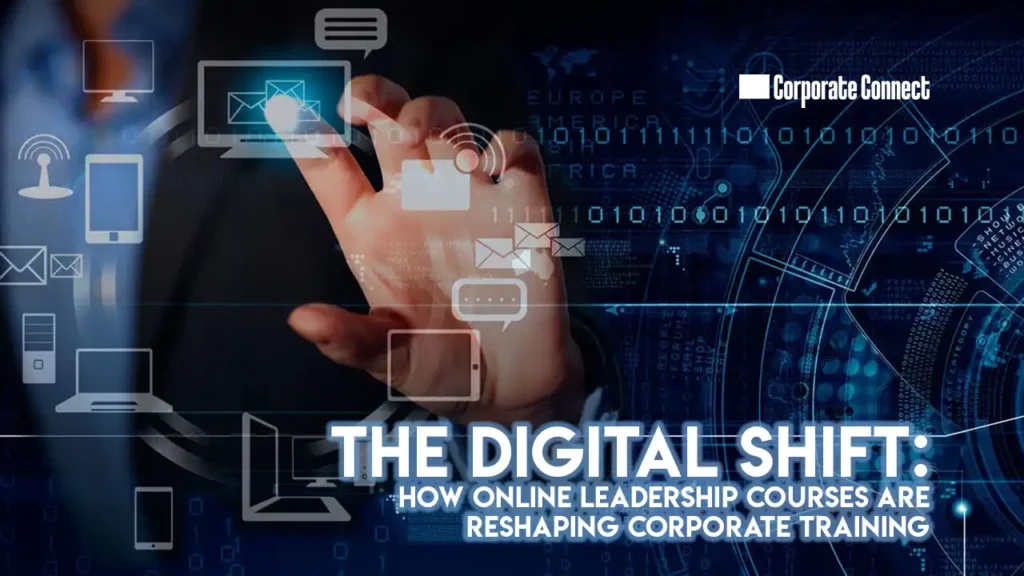The Digital Shift: How Online Leadership Courses Are Reshaping Corporate Training
The landscape of corporate training is undergoing its most significant transformation in a generation. For decades, leadership development was synonymous with off-site retreats, in-person seminars, and multi-day workshops. While effective, this traditional model has always faced challenges of scale, cost, and accessibility.
Today, a powerful new model has emerged, not as a replacement, but as a strategic evolution: online leadership courses. Driven by advancements in technology and a global shift towards flexible work, these programs are fundamentally reshaping how companies cultivate their next generation of leaders.
This isn’t just about moving content online; it’s about creating a more agile, personalised, and impactful learning ecosystem. As management expert Peter Drucker famously said, “The greatest danger in times of turbulence is not the turbulence; it is to act with yesterday’s logic.” In the context of corporate training, online learning is the new logic, providing a dynamic solution for a turbulent business world.
The Old vs. The New: A Paradigm Shift in Leadership Development
The move from traditional to online learning represents a fundamental shift in approach. The focus is no longer on one-time events, but on creating a continuous learning journey that is deeply integrated into a professional’s work life.
| Aspect | Traditional Training Model | The Modern Online Leadership Model |
| Accessibility | Limited to those who can travel; often reserved for senior executives. | Democratised: Accessible to managers at all levels, across all geographic locations. |
| Flexibility | Rigid, fixed schedules that require time away from work. | Flexible & Asynchronous: Allows professionals to learn at their own pace, without disrupting workflow. |
| Application | Concepts are learned in isolation and often forgotten by the time the leader returns to the office. | Immediate & Applied: Professionals can learn a concept in the morning and apply it to a real-world work challenge in the afternoon. |
| Cost-Effectiveness | High costs associated with travel, venue, and instructor fees. | Scalable & Efficient: Dramatically reduces overhead costs, allowing for wider deployment across the organisation. |
| Networking | Connections are limited to the small group present at the event. | Global & Diverse: Connects leaders with a diverse, global cohort, fostering a richer exchange of ideas. |
The Core Advantages Driving the Digital Revolution
The rapid adoption of online leadership courses is being driven by several key advantages that directly address the shortcomings of the traditional model.
1. The Power of Applied Learning
The most significant benefit of online learning is the ability to apply new knowledge immediately. A manager can learn about a framework for giving constructive feedback in a morning module and use that exact framework in a one-on-one meeting that afternoon. This “just-in-time” learning model dramatically increases retention and ensures that the training translates into tangible behavioural change. It closes the gap between theory and practice, which has always been the biggest challenge for traditional leadership training programs.
2. Democratizing Access to Elite Education
In the past, high-level leadership training was often an exclusive perk reserved for the C-suite or high-potential directors. Online programs break down these barriers. A mid-level manager in a regional office can now access the same world-class curriculum and faculty as a senior executive at headquarters. This democratisation of learning allows companies to build a deeper, more consistent leadership pipeline at every level of the organisation.
3. Fostering a Culture of Continuous Improvement
Leadership is not a one-time achievement; it’s a continuous practice. The flexibility of online learning supports this principle perfectly. Instead of a single, intensive “injection” of training once every few years, companies can now offer a portfolio of leadership courses that employees can access throughout their careers. This fosters a powerful culture of lifelong learning, where personal and professional growth is an ongoing journey, not a destination.
4. Building a Global and Diverse Peer Network
A common misconception about online learning is that it’s an isolating experience. In reality, modern online programs are designed for deep collaboration. A manager in India can be on a virtual project team with peers from the United States, Germany, and Brazil. This global exposure is invaluable, providing leaders with diverse perspectives and a rich network of international contacts that a single, in-person event could never replicate.
The Future is Blended and Bright
This is not to say that in-person training is obsolete. The future of corporate leadership development is blended. The most effective leadership training programs will combine the scale and flexibility of online learning with the high-touch, immersive experience of in-person campus modules. This hybrid model offers the best of both worlds: continuous, accessible learning combined with deep, relationship-building experiences.
In conclusion, the rise of online leadership education is more than just a trend; it’s a strategic response to the demands of the modern business world. By embracing this new model, companies are not just training their managers more efficiently; they are building a more agile, more capable, and more globally-minded generation of leaders, ready to navigate the complexities of tomorrow.
Must Read:








